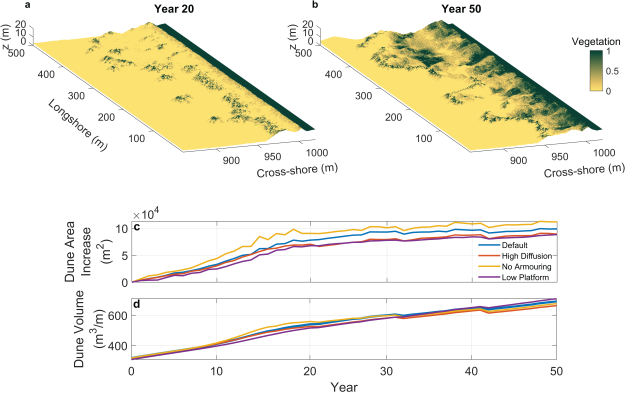M. Teixeira*, E.M. Horstman, K.M. Wijnberg
University of Twente, The Netherlands
* Corresponding author: m.teixeiramanion@utwente.nl
Introduction
Coastal sand nourishments have become a widespread strategy in response to coastal erosion and the need to strengthen coastal dunes for flood protection. Recently, a new strategy has been tested by upscaling from frequently recurring small-scale sand nourishments to a one-off local mega-nourishment (e.g. the Sand Motor). Such large volumes can significantly modify the natural beach-dune morphology, leading to an uncertain impact on its long-term evolution. Mega-nourishments may result in elevated berms and steeper cross-shore profiles that can alter the aeolian sand transport from the beach to the dunes, with the elevated berm leading to the formation of scarps through wave erosion (van Bemmelen et al., 2020). Furthermore, a mega-nourishment creates a planform perturbation of the coastline that will spread out in the alongshore direction, retreating locally whilst feeding the nearby coastline (Arriaga et al., 2017). Lastly, the use of coarser sediments in mega-nourishment construction may lead to the development of an armour layer on the beach, limiting aeolian transport (Hoonhout and de Vries, 2017). It is challenging to quantify and predict the development of mega-nourishments due to the diverse feedbacks involving aeolian dynamics, beach hydro- and morphodynamics, and vegetation development.
Objective and Methods
This study aims to enhance our understanding of how the morphological disturbances induced by mega-nourishments affect the long-term evolution of the beach-dune system. We investigate how the elevated berm, shoreline retreat, and beach armouring following a mega-nourishment affect dune emergence on the beach and foredune volume evolution.
We used the DuBeVeg model (Keijsers et al., 2016), a Cellular Automata model that includes the effects of aeolian transport, hydrodynamic erosion and accretion, and vegetation growth. Specifically, we used the modified DuBeVeg version of Teixeira et al. (2023) that considers saltation as the aeolian transport mode. The model was extended to include the coastline development and the effect of surface armouring on the beach. The model was validated by comparing its predictions with the measured morphodynamics of the Sand Motor.
Simulations were conducted for a 50-year period across four scenarios: the default scenario, representative of Sand Motor conditions with a high central berm and surface armouring; the high diffusion scenario, exploring the effect of accelerated shoreline diffusion; the no armouring scenario, examining the consequences of the absence of surface armouring; and the low platform scenario, investigating the impact of a lower, more hydrodynamically exposed berm.
Results
Results for the default scenario showed a seaward expansion of the initial dune zone, connecting and evolving from the isolated embryonic dunes that emerged during the first years on the upper beach (Figure 1a,b). The area occupied by new dunes stabilized after 20 years (Figure 1c), indicating a transition from the emergence of new embryonic dunes to the growth of already established dunes. The total dune volume (considered as the volume above a 5 m +MSL plane) continued increasing (Figure 1d).
The no armouring scenario led to a 12% larger area occupied by new dunes, indicating that the absence of the armouring limitation resulted in the emergence of more and/or larger embryonic dunes. However, this scenario resulted in a 2% lower total dune volume after 50 years, due to the larger amount of sediment captured by emerged embryonic dunes on the beach, hindering sediment transport to the dunes. Alternatively, the low platform scenario resulted in 14% less dune area than the default scenario due to the beach exposure to hydrodynamic action, but the total dune volume after 50 years was 3 % larger.
These results underline the model’s utility for exploring design optimization for mega-nourishments.

DuBeVeg simulation results for the beach-dune evolution after a mega-nourishment: simulated surface evolution of the default scenario after (a) 20 and (b) 50 years; the long-term evolution of (c) the area occupied by new dunes (emergent new dunes and extension of the original foredune) and (d) the total dune volume for all scenarios
References
Arriaga, J., Rutten, J., Ribas, F., Falqués, A., Ruessink, G., (2017), Modeling the long-term diffusion and feeding capability of a mega - nourishment. Coastal Engineering, 121, 1–13.
Hoonhout, B., de Vries, S., (2017), Field measurements on spatial variations in aeolian sediment availability at the Sand Motor mega nourishment. Aeolian Research, 24, 93–104.
Keijsers, J.G.S., Groot, A.V. de, Riksen, M.J.P.M., (2016), Modeling the biogeomorphic evolution of coastal dunes in response to climate change. Journal of Geophysical Research: Earth Surface, 121, 1161–1181.
Teixeira, M., Horstman, E.M., Wijnberg, K.M., (2023), Conceptualizing Aeolian Sediment Transport in a Cellular Automata Model to Simulate the Bio-Geomorphological Evolution of Beach – Dune Systems. Journal of Marine Science and Engineering, 11, 1278.
van Bemmelen, C.W.T., de Schipper, M.A., Darnall, J., Aarninkhof, S.G.J., (2020), Beach scarp dynamics at nourished beaches. Coastal Engineering, 160, 103725.


